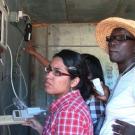This poster was presented by Michael Reid of the University of California, Davis, at the Horticulture Innovation Lab's (formerly Horticulture CRSP) 2010 Inception Workshop at the National Institute of Education in Singapore.
Postharvest losses: The 'low-hanging fruit'
In numerous studies, including a recent Gates Foundation survey conducted by the World Food Logistics Organization and the University of California, Davis, postharvest losses of perishable horticultural crops in the developing world have been estimated to average from 30 percent to 50 percent. Reducing this loss in value is an obvious opportunity for the Horticulture Innovation Lab (then called Horticulture CRSP) to have a significant impact on the livelihood of limited resource farmers.
Cool temperatures – the key to reducing losses
Low temperatures reduce metabolic changes, reduce water loss, slow the spread of postharvest diseases and limit responses to ethylene. In the developed world, refrigeration is universally recognized as key to the successful marketing of perishables. Temperature control is even more critical for produce in the developing world where ambient temperatures often are above 30°C, which can result in deterioration rates more than 20 times those at 0°C.
Goals of the CoolBot immediate impact project
- Test the CoolBot, an intriguing control system that makes a refrigeration system from a room air conditioner
- Evaluate a range of insulation materials that may be cheap and efficient alternatives to polyurethane panels
- Design a passive transportation container that will maintain that products remain cold during local marketing
The CoolBot
Although mechanical refrigeration is the best technology for cool rooms and transportation systems, conventional refrigerated shipping containers (also called reefers) are economically and practically infeasible for limited resource farmers The primary goal of this project is to test an innovative system, the CoolBot, which uses an intelligent thermostat system controlling a standard room air conditioner to create a small‐scale cooler out of a well-insulated room.
How it works
The CoolBot unit turns a conventional room air conditioner into a produce cooler. The air conditioner’s thermostat is heated so that the unit keeps running until the room temperature reaches the CoolBot set point. To prevent icing of the fins, the CoolBot measures the fin temperature and stops the compressor (through the thermostat heater) when ice builds up. The ice on the fins continues to cool the room air until it melts and the compressor turns on again.
Preliminary results
With funds from the Gates Foundation, we purchased and installed an air conditioner and CoolBot controller in an old cool room on the student farm at UC Davis. Total cost of the equipment was $650. Installation took two hours (including cutting the hole and installing the shelf to hold the air conditioner). The temperature trace shows that the system can hold temperatures relatively steady.
The collaborators in this Horticulture Innovation Lab project will install the system and evaluate its performance in India, Honduras, and Uganda.

